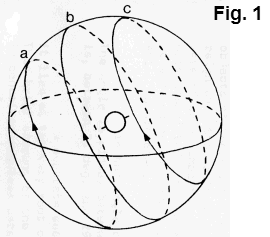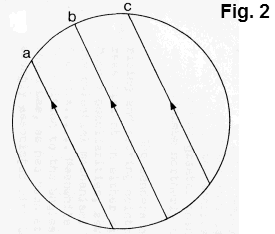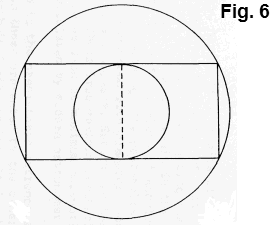
{17}
[Typescript reproduced in purple ink. Hectograph or similar.]
The traveller, who, in crossing a stretch of moorland in the darkness, sees in the distance a rapidly moving light, naturally concludes that the light is being carried by some vehicle, although the vehicle is invisible. Early man saw the heavenly lamps moving in curved lines across the firmament, and he reasoned that they were being carried round in circular fashion by some unseen vehicle.
The curvature of the trackway of each moving light, so carefully watched, suggested to him the most notable feature of his conception of the universe – a congregation of invisible spheres slowly, equably, and uniformly rotating, and carrying the celestial orbs.
The geometry and lay-out of prehsitoric monuments is based upon the conception of the universe as built of spherical, intangible shells, revolving one within the other. According to the old idea, not alone did a sphere carry a heavenly body fixed on its surface, but it carried the poles of another sphere.
The notion of the celestial mechanism has hitherto been attributed to the Greek, Eudoxus (530 B.C.) who was merely the first to attempt to register it in literary form (as detailed in Appendix*). But the conception indoubtedly originated in Palaeolithic times.
* [Not available]
From the prehistoric geometry it is apparent that the observer considered the centre of the celestial system to be the centre of the earth which he regarded as the centre of all things, with the heavenly bodies moving in great cycles around it. After, perhaps, many thousands of years, he seized upon the idea that the heavens above were formed of a concavity of invisible matter, on the inner surface of which were the fixed stars and the other heavenly bodies. At a later time his imagination {18} carried him still further to believe that, unseen, beneath him and his encompassing horizon line, was the other half of the concavity.
These conceptions eventually forced him to believe that the centre of the earth was the centre of immense transparent crystalline globes which were in slow motion equably and uniformly around him, the chief motions being from east to west <or> nearly so. Thus did he account for the daily swinging round of the body of the stars in the firmament.
His ideas gradually developed as he watched the more complex movements of the Sun, Moon and Planets. An assemblage of equably and uniformly rotating spheres became the basis of his ideas of the universe or cosmos generally, and of astronomy, time measurement, geometry, mathematics, metrology, religion and philosophy.
To assist the general reader, it may be well at this stage to give a brief account of some of the apparent motions of the celestial bodies, as seen by the early observer.
When we look at the heavens on a starry night, we see a speckled half-sphere, as though some great crystalline bowl, decorated with shining jewels, has been inverted over us. This apparent half-sphere we know to be only a portion of a great apparent sphere in which our world is set, the second portion being beneath our horizon and invisible.
We know that the Earth rotates, but the celestial sphere seems to wheel slowly round us. Each star is seen to come up out of the horizon towards the east and gradually to ascend, describing an arc of a size dependent upon its distance north or south; then it descends, describing still the arc of a circle, until it sinks out of sight towards the west and there dips beneath the horizon. Stars towards the extreme north as we see them in Britain, are non-rising and non-setting: they are always above the horizon and describe complete circles round the Pole. These motions go on all the year round.
The rising point of a fixed star does not vary as do those of the Sun, Moon, and Planets. For illustration let three (hypothetical) stars be considered. The observer would see three stars journeying round daily from east to west. From an imaginary position at the centre of a transparent earth he would see the complete circle of the star’s journey back again from west to east. The ovals in the following diagram are foreshortened circles, representing the trackways of the three stars.
The small circle in the centre represents the earth. The picture of this system is seen from a distance on a plane slightly obliquely set to the plane, W.E. (see fig. 1).

Now substitute for the above a picture of the same system as seen from an infinite distance from a position in the plane W.E. The pathways of the three stars thus portrayed from a slightly different standpoint – are seen not as ovals but as straight lines, see fig. 2:

This aspect (not No. 1) is commonly portrayed in rock markings.
The next diagram shows another aspect of the supposed star-mechanism, also portrayed in the ancient geometry. The view (fig. 3) is now that obtained from a position at an infinite distance above either of the poles (at right-angles to the W.E. plane). The pathways are now shown in their true shape as circles. The pathway of the middle star, of course, coincides with the circumference of the star-sphere. The pathways of the other two stars coincide and appear as one circle.

{19} The outer circle in each diagram represents the great star-sphere, its axis lying north and south, being, indeed, the axis of the Earth produced. The star-sphere, of course, seems to wheel round from east to west, because the earth is rotating in the opposite direction. The position of the lines representing the apparent paths cf a given star never perceptibly alters. (There is a very slight long-drawn-out alteration which need net here be considered, since it does not seriously affect and [sic – any M.B.] study of the astronomical monuments of antiquity).
This constancy in the position of fixed stars rising and setting, and consequently in lines representing their paths, does not apply, however, to lines representing the movements of the Sun, Moon and planets. These bodies travel not only daily east and west, but * from the W.E. plane is, at maximum, 26½ degrees – an angle which it will be shown, is strongly emphasized in the monuments, and in very ancient times was treated as a fundamental angle.
* <Some words evidently omitted, either from the original typescript or from the 1977 edition.>
Only at two seasons does the Sun rise due east and set due west. This occurs at the March and September equinoxes, when the apparent path of the Sun is the same as that of the middle star (b) in the foregoing diagrams.
After the March equinox (the “Pasch” or Passover of the Hebrews), when the Sun passes over the equator, it is seen to rise and set gradually further north until at the June solstice its rising point (as seen from the equator) is about 23½ degrees from due east and west. The value of this angle varies slightly from epoch to epoch (in...B.C. it was 24 deg.). June 21st being past, the Sun’s rising and setting points return southward and after once more passing the position E.W. at the September equinox, they alter still further southwards. About December 22, a point 23½ deg. south is reached.
One of the many veiled scriptural references to the ancient science described the ram of Daniel’s vision (Daniel viii. 3–4) as “pushing westward, and northward, and southward” – an allegory of the threefold movement of the celestial bodies – westward, each day, northward from December till June, and southward from June till December.
The following diagram illustrates the apparent movement of the Sun (fig. 4.).

This diagram shows only one view of the supposed celestial mechanism – that seen from an infinite distance at right-angles to the earth’s axis. As with the fixed stars, a second aspect was portrayed by the ancient geometers – that seen from an infinite distance looking down, as follows:– see fig. 5.

The foregoing diagrams explain why as will be shown each ancient linear measure had two time-values. One is the value seen in plan at the equinoxes, the other is the reduced projection value when seen in plan at the solstices. The same time-value is represented to each, because the same movement is portrayed in each, namely, one revolution of the solar-year sphere.
The angle which determined the value of the standard projection measure was 26½ deg. – the mean of Sun and Moon maximum declination. The double motion of the sun was anciently attributed to two separate spheres, one rotating from east to west in one day; its axis lying north and south; and the other accomplishing its journey in 365¼ days, the resulting compound motion causing the apparent seasonal changes of path.
{20} The name “ecliptic” from the Greek, was given to the invisible line or apparent path of the Sun in the heavens, because it is the zone in which the Sun and Moon eclipses are seen to take place. It is, of course, really the plane of path in which the earth moves round the Sun, as seen by an observer of the Sun.
The angle which the plane of this path forms with the earth’s equator is called the angle of obliquity of the ecliptic. The angle has been subject to a small, irregular diminution since that [sic] time of the earliest historical observations. The amount and rate of the change have now been assessed. Since the time of most of the monuments herein described, the obliquity has been growing less, but in Palaeolithic times, it more than once reached its limit in either direction, the range being about 1½ degrees on either side of the mean value of about 24 degrees. After some 25,000 * years it returns to the same value.
* [Typescript unclear]
An observer at the equator at the June or at the December solstice in modern times sees the Sun rising and setting 23 deg. 27 min. from the equator. As he travels northward he sees the sun rising and setting at a gradually increasing angle north of the equator. At Greenwich he sees it rise at midsummer 40 deg. north of east. In winter 40 deg. south of east.
The ancient astronomer not only recorded what he saw in the heavens in his own country, but, incredible as it may appear to modern students, he had an academic understanding of the principles (always remembering that he believed the earth to be the centre of the celestial system). The prehistoric designs portray the theoretical as well as the local aspects, That a very broad view of geodetic and astronomical matters was taken by the pre-classical scientists is clear from the conception, and from the equally astonishing fact that the details of the eclipse mechanism (at least as regards time elements) were fully understood. Eclipses, whether visible or invisible from a particular place, were foreseen and computed.
So far, we have considered only the fixed stars and the Sun. For simplicity, the star-diagram was shown with the three hypothetical stars in, respectively, the Sun’s midsummer, equinoctial and midwinter positions. Similar ideas were held regarding the planets. They were also conceived of as borne round by invisible spheres. The planets followed the sun in its northward and southward seasonal journeyings, and the maximum angle or declination was always in a fixed relationship to thatof the Sun. The foregoing figures apply (with but slight change of angle) to the five anciently known planets. While the Sun angle was anciently about 24 deg., those of the five planets were portrayed as follows:
Saturn 24 deg. 50 min., Jupiter 25 deg. 28 min., Mercury 26 deg. 22 min., Venus 27 deg. 12 min., Mars 27 deg. 50 min.
The figures given do not express the actual planetary declinations as known to modern science, which in the case of Venus and Mercury are greater than here stated. The ancient scientists registered what they saw with the naked eye. They were unaided by the telescope, or by knowledge that the Sun was the centre of the system. At any rate they based their geometry upon a geocentric system, and on what they actually observed. There is clear proof that there is no ground for the rash statements of religionists to the effect that the ancients had knowledge equal to that of mechanically assisted scientists of today.
{21} Venus and Mercury, having their orbits within that of the earth, and because of their nearness to the sun at their mathematical maximum declinations, could not be seen. The sighting posts at Stonehenge – recently uncovered – clear traces of which remain in the socket holes, provide an excellent index to the refined state of knowledge attained by the British Neolithic observer (although the post-holes have not, until now, been recognised as connected with planetary observations or indeed with astronomical affairs). Jupiter, Saturn and Mars are recorded at Stonehenge at approximately their true maximum northerly angles, but Venus and Mercury are recorded as seen at maximum northerly angles considerably less than those calculated by modern astronomers.
The Moon offered to the prehistoric astronomer a problem in some respect more subtle than those presented by the other bodies, because she has a double motion round both Earth and Sun. It is, however, not necessary to enter deeply into lunar astronomy, the ancients having treated it in much the same way as solar and planetary astronomy, attributing everything to the spheres. While the planets had maximum declinations of a fixed amount greater than that of the Sun, the Moon has both a maximum and a minimum northerly and southerly digression.
She wanders on either side about 5 degrees away from the Sun’s rising and setting points. At Stonehenge she is seen as much as ten degrees distant on either side from the sun’s rising point. To explain the Moon’s peculiarities, several spheres were conceived to be involved in the celestial mechanism. The question is more fully dealt with in the Appendix...... Meanwhile sufficient has been said for present purposes. In addition to the angles of declination of the Sun, Moon and planets, there was, as has been stated above, an angle of 26½ degrees now often wrongly associated with the star [Alpha] Draconis.
The Sun and Moon were anciently and naturally out-standing objects of regard. The Sun was the sovereign lord of day; and the Moon’s reign over the world of darkness was likewise supreme. The Moon’s periods were of great importance in the keeping of the calendar. Sacred rites were associated with her appearances. Many events in the Pagan calendars were dated by the Moon’s phases, and indeed Christian sacred days are still so dictated.
In the angle of 26½ deg. both Sun and Moon were recognised. The angle is midway between those of the Sun and Moon at maximum, that is, between 24 deg. and 29 deg.
A separate section is devoted to this important angle since it lies at the very root of the old geometry, measures and architecture. This brief account of the portrayal of the celestial mechanism as anciently conceived requires careful consideration, because it enters into every place of prehistoric geometry. It explains, for instance, why every prehistoric carving or monument is planned so as to embody the idea of an imaginary rectangle exactly enclosed by a circle <fig. 6>.

The rectangle is the frame, so to speak, of the field of sculpturing or building. The enclosing circle represents the total time recorded. The larger the circle the larger the time recorded. This standard diagram is a plan of the spherical mechanism as already described, the four corners at the [words missing? – M.B.] representing points on the surface of a sphere – such as maximum northern and southern rising and setting points.
{22} The angle formed by the diagonals of the rectangle was usually associated with one of the celestial bodies or with the luni-solar angle of 26½ deg., but sometimes with nineteenths or sub-multiples of nineteenths of the circle. This framework was never permanently delineated. It may temporarily have been shown as by painting whilst the plan was being made, but it is now invisible. To read the story of the designs, the imaginary framework must always be reconstructed: It is the prime key to their meaning.
It has been shown that the ancients conceived the celestial mechanism to consist of an assemblage of invisible, crystalline spheres, in concentric sets, and rotating equably and uniformly one within the other in each group. These served as vehicles for the celestial bodies. Compound movements of the bodies were explained by other spheres, to which were attached the poles of those carrying celestial bodies.
The geometry of the rock-carvings and monuments is a portrayal of the spheres, as seen from either or both of two views – from an infinite distance above, or from an infinite distance at right-angles to the first direction.
Upon this framework, now seldom seen, essential points were marked, and now survive as cups and analogous designs suggested by cup-marks or salient points of the monument or carving. The Sun, Moon, and planets at midsummer and midwinter were portrayed as rising and setting with [sic] a narrow zone, the medial line of which was at maximum about 26½ deg. from east and west, as seen at the equator.